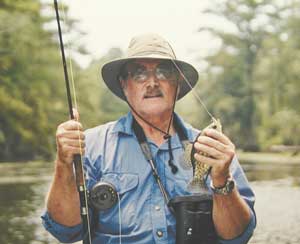
The offshore fleet was walloped by Katrina and Rita, but fast action is luring them back.
Find a list of North America’s great fly-fishing waters, and it’s a sure bet that list will include the coral flats of South Andros, the mangrove-lined creeks of south Florida, the meadow streams of Yellowstone and the salmon-filled rivers of Alaska. And more so than in the past, you’ll probably find the mouth of the Mississippi River or the Louisiana Marsh mentioned as well.
Certainly nobody ever puts the Bayou Gauche Drainage Canal or the Shadowbrook Ditch in that list.
And yet, when it comes to crappie, alias white perch, alias sac-a-lait, there’s little doubt that there are trophies of this species lurking in some of our state’s finest drainage waters. I’ve seen a couple of fish over 3 pounds pulled from the ditch in my neighborhood, one of which was listed in the state top 10 for some years.
In fact, the all-tackle state record was caught in a New Orleans canal, and weighed exactly 6 pounds!
I’ve also seen some “slabs” pulled from a sewage pond back in my hometown. I’m convinced if I dug a hole in my yard and let it fill with water, eventually it would produce big sac-a-lait.
This is about as ideal to an urban fishery as there is, or at least one that is accessible to everyone. Best of all, it’s one that is well suited for the fly rod.
All it takes to catch sac-a-lait is the basic tackle, and a selection of no more than five different flies. The basic tackle being a rod, reel, line, backing and leader.
The most important piece of equipment is the rod. A good casting rod can make for a pleasurable experience, and improve your “luck.” A poor rod will cause you to struggle both with casting and catching fish.
Searching for a good first rod? Look for one made of graphite that has a cork grip, chrome or stainless steel guides and a reel seat with good fit.
An easy way to tell if the rod is of decent quality is to count the number of guides on the rod, not including the tip top. If the number of guides is less than the length of the rod in feet, then it’s likely not a decent rod.
Fly rods and lines are rated by a weight number, usually 1 to 15. Your typical 1-weight can tackle small bluegills; your typical 15-weight can tackle blue marlin.
For a first rod, a 5-weight is a wise choice since it can handle a wide variety of flies, freshwater species and fishing conditions. My favorite for bream and sac-a-lait is an 8-foot 5-weight. It can cast popping bugs, but also handle small bass bug poppers and has enough backbone for rigs using mini-corks.
Line options for fresh water will include either a “weight-forward, floating,” designated as WF-F, or a “double-taper, floating,” designated as DT-F.
The weight forward has the advantage of being easier to shoot line, but the double taper can be reversed once one end of the line starts to wear out.
Get a decent reel to match. Starting at about $30, you can buy an all-metal reel with a click drag. From $50 on up, most reels have disc drags — good for when you accidently hook into a bass or striper.
Avoid automatic fly reels like the bird flu. They’re heavy and prone to corrosion.
Since fly line is 100 feet long, or less, a big fish could spool your reel without backing. Backing is a dacron line that not only provides insurance, it helps decrease fly line memory by increasing the width of the coils. For freshwater, 75 to 100 yards of 20-pound dacron will suffice.
The leader is a tapered monofilament section that connects fly line to fly. For most bream and sacalait fishing, I use a leader about 6 to 8 feet long.
Making your own leaders is fun. A simple leader consists of three sections: a thin section to which the fly is tied, called the “tippet;” a thick section attached to the fly line, called the “butt,” and a middle section called the “midsection.”
If you told a group of folks that your butt was 14 pounds, your midsection was 10 pounds and your tippet was 5 pounds, you would certainly get some strange looks.
I know a lot of women who wish their butts or midsections were that size, and a few guys who wish their “tippets” were that size.
But what you’d be describing to said folks is the ideal crappie leader. It’s light and subtle so as to detect the delicate strike for which this species is notorious.
When it comes to flies, the Fluff Butt rules supreme. More white perch have been taken on this fly than any other. Tied on either a jighead or with a beadhead and hook, it has a chenille body and a marabou tail.
One reason why the fly isn’t sold commercially is because it’s little more than a beadhead wooly bugger minus the hackle. No surprise then that the second most popular fly is the wooly bugger itself.
Other popular flies include mini-Clousers, small Charlies, Crystal Shrimps, beadhead Prince Nymphs and Hare’s Ears, and Gummy Minnows.
If you fish the Fluff Butt, then your options are to swim/strip in the retreive, or fish it under a tiny float. The second option keeps it in the sac-a-lait’s strike zone longer. It’s always fun to watch the cork jiggle on the surface then plunge under as the fish grabs the prize below.
Best colors include dark olive, black, red/white, blue/white and chartreuse. Keep in mind the old saying “bright days, bright colors; dark days, dark colors,” and you’ll be in great shape.


